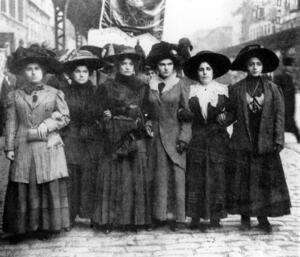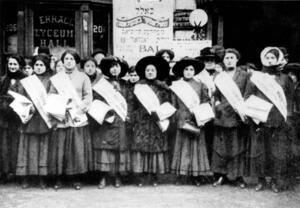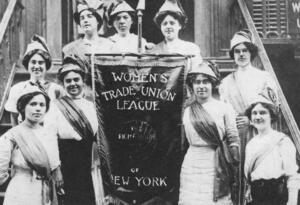ILGWU office
The International Ladies' Garment Workers' Union (ILGWU) was founded in 1900 and had its offices at 11 Waverly Place at the time of the Triangle fire. The union's male leaders were not especially interested in organizing the women workers who dominated the garment industry. That changed with the "Uprising of the 20,000" in 1909. Once the strike was underway, the leaders of the ILGWU reluctantly supported it, which marked a major change in the status of women in the labor movement.
The leaders of this union for workers who made women's clothing were men who questioned whether women had a role to play in the labor movement. Clara Lemlich understood how important it was for the union to serve women. In 1906, along with six other women shirtwaist makers, she started Local 25.
The Women's Trade Union League (WTUL), formed in 1903 to protect female workers, was an early ally of the ILGWU. The WTUL was unusual in having members from among the working class and the middle and upper classes active in the progressive movement. Cultural, class, and ethnic differences created tension within the League, but the WTUL's help was critical to the success of the 1909 strike.

The Uprising of the 20,000 is the largest strike by women to date in American history. It is estimated that around thirty thousand workers participated in the strike during its eleven-week duration, 90 percent of whom were Jewish and 70 percent women.
Courtesy of International Ladies' Garment Workers' Union Archives, Kheel Center, Cornell University.
First, there was financial support. Local 25 had only $4 in its budget at the beginning of the strike. The financial support of WTUL members such as J.P. Morgan's daughter Ann and the wealthy suffragist Alva Belmont also helped the strikers gain credibility, public sympathy, and physical protection. Police treated strikers far more gently when middle-class women marched beside them on the picket line. And then there was the publicity. The involvement of middle-class and society women ensured that major papers like the New York Times, and not just the Jewish Forward, covered the strike.
In the aftermath of the Triangle fire, the relationship between the WTUL and the ILGWU deteriorated as the two organizations took different approaches to organizing. When the ILGWU called for a strike in the fall of 1911, for the first time the WTUL did not endorse it. The League began to focus on organizing American-born women working in uptown shops rather than the immigrant women employed in downtown factories.






the fire was intention. they murdered those ppl to put down the resistance
I'm trying to find my dress that I bought it has the original women's Union tag please email
Do you have any records about Yiddish Theatre and the ILGWU annual show?